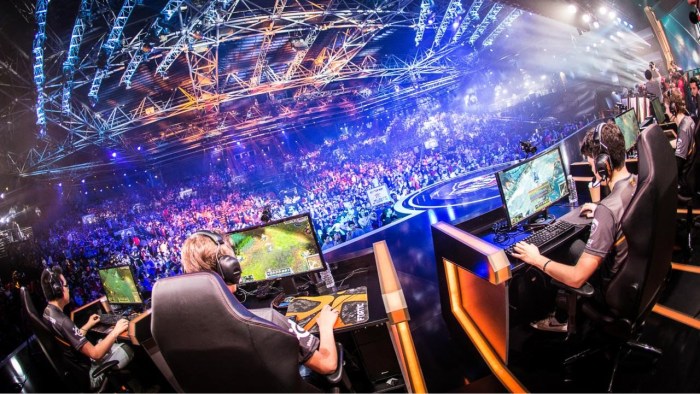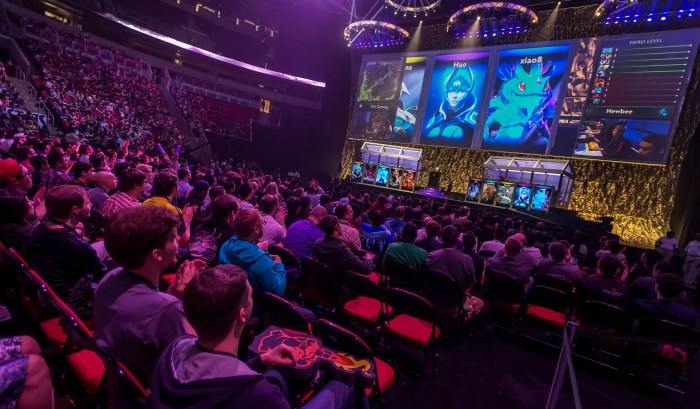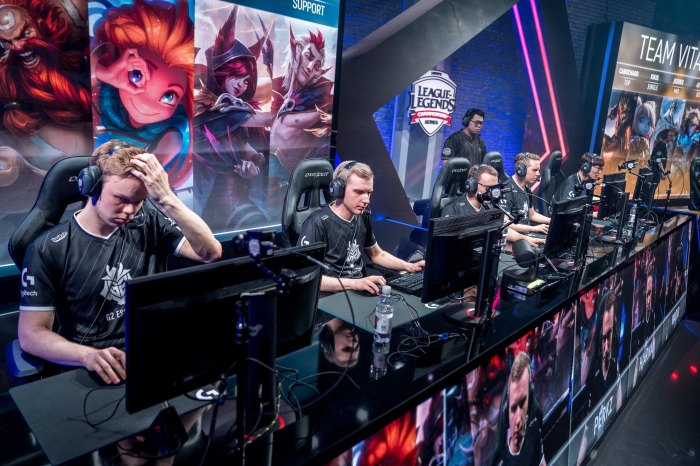Competitive gaming – Competitive gaming, or esports, has exploded in popularity, transforming from basement LAN parties to massive, globally televised events. Technological advancements, particularly high-speed internet and streaming platforms like Twitch and YouTube, have fueled this growth, allowing millions to watch and participate in the excitement. From the early days of
-StarCraft* to the modern behemoths like
-League of Legends* and
-Fortnite*, the evolution of competitive gaming is a fascinating story of innovation, community building, and big business.
This evolution encompasses diverse game genres, each with its own unique competitive landscape. We’ll explore the strategies and tactics of MOBAs, FPS games, fighting games, and strategy games, examining the different roles players fill and the unique challenges each genre presents. Beyond the gameplay, we’ll delve into the business side of esports, from sponsorship deals and merchandise sales to the complex organizational structures of professional teams.
We’ll also explore the passionate community that fuels this industry, from dedicated viewers to the players themselves, and examine the future of competitive gaming and the challenges it faces.
The Rise of Competitive Gaming

Competitive gaming, or esports, has exploded in popularity, transforming from a niche hobby to a global phenomenon. Its evolution is a fascinating blend of technological advancements, shifting cultural attitudes, and savvy entrepreneurialism. What began as informal gatherings of players has blossomed into a multi-billion dollar industry with dedicated arenas, professional teams, and millions of dedicated fans.
Technological Advancements Fueling Esports Growth
The rapid growth of esports is inextricably linked to key technological advancements. High-speed internet access broadened the reach of online multiplayer games, allowing for seamless global competition. The development of powerful gaming PCs and consoles provided the necessary hardware for high-fidelity graphics and responsive gameplay, enhancing the viewing experience for both players and spectators. Crucially, improved game design, focusing on balanced gameplay and spectator-friendly features, created games specifically suited for competitive play.
Games like
- StarCraft*,
- Counter-Strike*, and
- League of Legends* exemplify this design shift, incorporating elements that make matches engaging and easily understandable even for casual viewers.
The Impact of Streaming Platforms on Esports Popularity, Competitive gaming
Streaming platforms like Twitch and YouTube Gaming have been instrumental in catapulting esports into the mainstream. These platforms offer unparalleled access to competitive matches, allowing viewers to watch professional players in real-time, interact with communities, and engage with streamers. The accessibility and social nature of streaming have democratized esports, allowing anyone with an internet connection to participate in the community, whether as a viewer, a player, or a content creator.
This has significantly boosted the visibility and popularity of esports, creating a virtuous cycle of growth. The rise of prominent streamers and esports personalities has further solidified the cultural relevance of competitive gaming.
A Timeline of Major Milestones in Competitive Gaming History
The following table provides a snapshot of key moments that shaped the competitive gaming landscape.
| Date | Event | Impact | Key Players |
|---|---|---|---|
| 1972 | First documented video game competition (Spacewar!) at Stanford University. | Established the concept of competitive gaming. | Stanford University students |
| 1980s-1990s | Rise of arcade gaming and early LAN parties. | Increased accessibility and fostered community. | Various arcade game developers and early PC gamers. |
| 1997 | QuakeCon, one of the first major esports events, is held. | Formalized the structure of competitive gaming events. | id Software |
| 2000s | Broadband internet becomes widespread, enabling online competitive gaming. | Globalized competitive gaming and expanded viewership. | Various internet service providers and game developers. |
| 2010s | Rise of Twitch and YouTube Gaming; esports organizations and sponsorships grow significantly. | Mainstreamed esports and led to professionalization. | Twitch, YouTube, various esports organizations and sponsors. |
| 2020s | Esports continues to grow in popularity and viewership, with increasing investment and media coverage. | Esports is now considered a mainstream sport. | Numerous professional players, teams, and organizations. |
Game Genres and Their Competitive Scenes

The world of competitive gaming encompasses a vast landscape of genres, each with its own unique competitive ecosystem. From the strategic depth of MOBAs to the lightning-fast reflexes demanded by FPS games, the differences in gameplay mechanics, player roles, and overall strategies create wildly diverse competitive scenes. Understanding these differences reveals the core elements that make certain genres thrive in the competitive arena.
MOBAs: Teamwork and Strategic Depth
MOBAs, or Multiplayer Online Battle Arenas, like Dota 2 and League of Legends, are defined by their intricate team-based gameplay and high skill ceiling. Success hinges on coordinated team compositions, strategic map awareness, and precise execution of complex team fights. The competitive scene is characterized by intense strategic planning, both in-game and out. Teams meticulously analyze opponents, draft heroes based on predicted strategies, and practice extensively to master intricate team maneuvers.
Different roles within MOBAs contribute to overall team success:
- Carry: Deals the majority of the team’s damage in the late game.
- Support: Protects and enhances the team’s carry.
- Mid-laner: A versatile role often responsible for controlling the map’s central area.
- Off-laner: A durable hero that can withstand early-game pressure.
- Jungler: Controls neutral monsters to gain advantages across the map.
First-Person Shooters (FPS): Reflexes and Precision
FPS games, such as Counter-Strike: Global Offensive (CS:GO) and Valorant, prioritize individual skill and fast reflexes. Competitive play revolves around precise aim, strategic positioning, and quick decision-making under pressure. While teamwork is important, individual performance significantly impacts the outcome of matches. The competitive landscape is often marked by intense individual rivalries and a constant arms race of improving aiming techniques and tactical strategies.
Player roles in FPS games often revolve around specific playstyles:
- Rifler: The all-around player, proficient with various weapons and situations.
- AWPer: Specializes in long-range engagements with high-powered sniper rifles.
- Support: Provides utility and assists the team through information gathering and tactical support.
Fighting Games: Precision and Execution
Fighting games, such as Street Fighter V and Tekken 7, demand exceptional precision, reaction time, and an in-depth understanding of character matchups and game mechanics. Competitive success depends on mastering intricate combos, reading opponents’ movements, and adapting to different playstyles. The competitive scene is known for its deep strategic layers hidden within the seemingly simple act of button-mashing, and its focus on individual skill and execution.
Roles in fighting games are less defined than in team-based genres, but player styles can be categorized as:
- Rush-down player: Aggressive and offensive, aiming to overwhelm opponents.
- Zoner: Keeps opponents at a distance with projectiles and ranged attacks.
- Grappler: Focuses on close-range combat and grappling techniques.
Real-Time Strategy (RTS): Macro and Micro Management
RTS games, such as StarCraft II and Age of Empires IV, require players to manage resources, build bases, and control armies in real-time. The competitive scene emphasizes both “macro” strategies (long-term planning and resource management) and “micro” strategies (precise control of individual units during combat). The depth and complexity of RTS games lead to highly strategic and dynamic matches, where even minor errors can have significant consequences.
RTS players often specialize in different aspects of gameplay:
- Macro-focused player: Prioritizes efficient resource management and base building.
- Micro-focused player: Emphasizes precise unit control and combat maneuvers.
- All-around player: Balances macro and micro strategies effectively.
The Business of Competitive Gaming

Esports has exploded in popularity, transforming from a niche hobby into a multi-billion dollar industry. This growth has been fueled by a complex interplay of factors, including increased viewership, lucrative sponsorship deals, and the development of sophisticated business models within the esports ecosystem. Understanding the financial underpinnings of competitive gaming is crucial to grasping its current success and predicting its future trajectory.The revenue streams in esports are diverse and constantly evolving.
While prize pools remain a significant draw for players, they represent only a fraction of the overall income generated. The real money lies in the sophisticated business strategies employed by teams, leagues, and organizations.
Revenue Streams in the Esports Industry
Several key revenue streams contribute to the profitability of esports. Sponsorships, for example, are a cornerstone of many esports organizations’ financial models. Major brands like Red Bull, Coca-Cola, and even car manufacturers invest heavily in sponsoring teams, tournaments, and individual players, gaining exposure to a highly engaged and passionate audience. Merchandise sales, ranging from team jerseys and branded apparel to gaming peripherals, provide another consistent income stream.
Streaming platforms like Twitch and YouTube, through subscriptions and advertising revenue shared with streamers and organizations, play a critical role. Ticket sales for live events and in-game purchases also contribute significantly to the overall revenue. Finally, investments from venture capitalists and other investors are increasingly fueling the growth of the industry. These investments support the expansion of teams, the development of new leagues, and the creation of innovative business models.
The Role of Game Developers in Fostering Competitive Gaming
Game developers are essential to the success of competitive gaming. Their active involvement in cultivating a competitive environment significantly influences the growth and sustainability of the esports scene. Features specifically designed for competitive play, such as robust anti-cheat measures, spectator modes, and regular balance patches, are critical. Furthermore, the developers’ commitment to supporting esports tournaments and leagues through direct financial contributions or official partnerships is paramount.
Actively engaging with the community and responding to player feedback helps build trust and ensures the longevity of the game within the competitive landscape. Games like League of Legends and Dota 2, known for their robust competitive scenes, exemplify the success of this collaborative approach between developers and the esports community. Conversely, a lack of developer support can lead to the decline of a game’s competitive scene, even if initially popular.
Examples of Successful Esports Organizations and Their Business Models
Several esports organizations have achieved remarkable success by implementing effective business strategies. Team Liquid, for example, has diversified its revenue streams through sponsorships, merchandise sales, content creation, and player management. Cloud9, another prominent organization, has successfully built a brand around its team and players, leveraging this brand recognition to secure lucrative sponsorship deals and merchandise sales. These organizations often employ a multi-faceted approach, combining team management with content creation, talent scouting, and strategic partnerships to maximize their profitability.
Their success highlights the importance of a well-rounded business model that goes beyond just winning tournaments. The strategic use of social media and other marketing channels is also a crucial component of their success.
Hypothetical Business Plan: A New Esports Organization Focused on Fighting Games
This hypothetical business plan focuses on a new esports organization, “Fighting Fury,” specializing in the competitive fighting game scene. The organization would focus on recruiting top-tier fighting game players, primarily in titles like Street Fighter 6 and Tekken 8. Revenue would be generated through a mix of sponsorships (targeting brands that align with the fighting game community), merchandise sales (featuring unique designs appealing to fighting game enthusiasts), and content creation (streaming matches, creating highlight reels, and producing educational videos on fighting game strategies).
The organization would also explore opportunities for participation in major fighting game tournaments and the creation of smaller, community-focused events to foster grassroots growth and engagement. This model relies on building a strong community around the team and creating high-quality content to attract sponsors and fans, mirroring the successful strategies of established organizations in other esports genres. The long-term goal is to establish Fighting Fury as a leading organization in the competitive fighting game scene, building a sustainable and profitable business through strategic partnerships, community engagement, and content creation.
The Players and Teams

The world of competitive gaming, or esports, wouldn’t exist without the incredibly skilled players and the teams that support them. These individuals dedicate their lives to mastering their chosen games, often facing intense pressure and competition. Understanding the players, their training regimens, team dynamics, and the overall competitive landscape is crucial to appreciating the depth and complexity of the esports industry.
Professional gamers, often referred to as esports athletes, represent the pinnacle of skill and dedication within their respective games. Their training is rigorous, often involving hours of practice, strategic analysis, and physical conditioning. Team dynamics play a significant role in success, requiring effective communication, coordination, and trust amongst teammates.
Prominent Professional Gamers and Teams
Many professional gamers have achieved legendary status within the esports community. For example, Lee “Faker” Sang-hyeok, a South Korean League of Legends player, is widely considered one of the greatest of all time, known for his exceptional mechanical skill and game sense. Similarly, Oleksandr “s1mple” Kostyliev, a Ukrainian Counter-Strike: Global Offensive player, is renowned for his aggressive playstyle and incredible aim.
These players are often associated with highly successful teams like T1 (Faker’s former team) and Natus Vincere (s1mple’s current team), organizations that invest heavily in their players and provide comprehensive support systems. Other prominent teams include Fnatic (League of Legends, Valorant, etc.), G2 Esports (League of Legends, Valorant, etc.), and Cloud9 (League of Legends, Valorant, Counter-Strike).
Training and Lifestyle of a Professional Competitive Gamer
The life of a professional competitive gamer is demanding and highly structured. Days are often filled with intense training sessions, strategic planning, and scrims (practice matches against other teams). Many players follow rigorous training schedules, dedicating hours each day to honing their skills and studying opponent strategies. Physical health is also a key component, with many professionals incorporating fitness routines to maintain focus and prevent burnout.
While the lifestyle can be rewarding, it also demands significant personal sacrifice, often requiring players to forgo a traditional education or social life to pursue their competitive careers. The pressure to perform at a high level can be immense, leading to stress and mental health challenges.
Team Dynamics in Different Esports Organizations
Team dynamics vary significantly across esports organizations, reflecting different management styles and team compositions. Some organizations prioritize a highly structured and disciplined environment, with strict rules and expectations. Others foster a more relaxed and collaborative atmosphere, emphasizing player autonomy and creativity. The communication styles within teams also differ widely, ranging from highly formal and strategic discussions to more casual and intuitive interactions.
Successful teams often find a balance between structure and flexibility, allowing players to perform at their best while maintaining a cohesive and supportive team environment. Factors such as cultural background, player personalities, and coaching styles all contribute to the unique dynamics within each team.
Comparison of Top Three Teams in League of Legends
League of Legends boasts some of the most intense team rivalries in esports. To illustrate the nuances of team dynamics and competitive performance, let’s compare three top teams (as of late 2023 – rankings fluctuate frequently). Note that this is a snapshot in time and team performance can change rapidly.
| Team Name | Strengths | Weaknesses | Notable Players |
|---|---|---|---|
| T1 | Exceptional macro play, strong team fighting, consistent performance | Can sometimes struggle against aggressive early game strategies | Faker, Oner, Keria |
| JDG | Dominant early game, aggressive playstyle, exceptional individual skill | Can be susceptible to late-game collapses if their early lead isn’t secured | 369, Kanavi, Ruler |
| Gen.G | Excellent laning phase, diverse champion pool, strong team coordination | Can sometimes lack the explosive early game pressure of other top teams | Doran, Peanut, Chovy |
FAQ Overview
What are the most popular competitive games right now?
Currently, titles like
-League of Legends*,
-Dota 2*,
-Counter-Strike: Global Offensive*,
-Fortnite*,
-Valorant*, and
-Call of Duty* consistently rank among the most popular competitive games, boasting large prize pools and dedicated player bases.
How do professional gamers make money?
Pro gamers earn income through tournament winnings, sponsorships from brands, streaming revenue (subscriptions and donations), salaries from esports organizations, and merchandise sales.
Is competitive gaming a viable career path?
While highly competitive and requiring immense dedication, a career in competitive gaming is possible for a select few. Success depends on skill, talent, consistent practice, and often a bit of luck.
What are the health risks associated with competitive gaming?
Prolonged gaming can lead to eye strain, carpal tunnel syndrome, sleep deprivation, and other physical and mental health issues. Maintaining a healthy balance is crucial.
